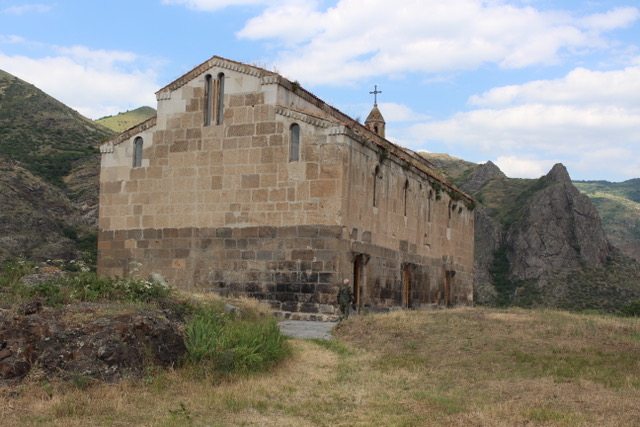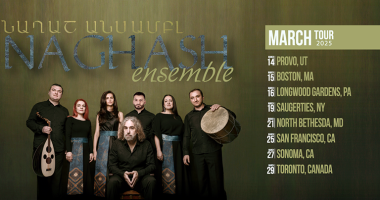By Hovsep Daghdigian
On my map of Armenia and Artsakh is a church named “Mknatam Khach”; literally translated as “Mouse’s Tooth Cross”. The church is located in the Lachin Corridor, Kashatagh region, the first region encountered when entering Artsakh from Armenia over the Goris to Stepanakert highway.
This intriguing name prompted my close friend Vova and I to search in vain for this church during visits to Artsakh during the previous two years. This year was our 3rd attempt. While our map showed the church, it lacked sufficient details to guide us there. Other than one main road heading north from the main Goris – Stepanakert highway, which is in very poor condition, roads within this area consist mostly of dirt tracks through fields and valleys. Maps offer little help in such a situation.


As one enters Artsakh (Karabakh), there is a check point at the Armenia – Artsakh border flying Armenian and Artsakh flags. Crossing the check point into Artsakh poses no problems. The road to the left, going north along the left bank of the Aghavno River, heads towards Melikashen and Tsitsernavank. To the left is the river and its green valley. Visible are Azeri houses abandoned during the Karabakh war, orchards, and occasional herds of grazing cattle. Towards the right are cliffs, some of which have been carved away to make way for the road, and in other places are dry fields backed by cliffs. To the left is greenery, to the right the scene is mostly arid. The river hosts a number of hydroelectric stations, I counted three, with new power lines strung along the roadside. There may be fish farms there as well, I’m not sure. The road is dusty with rocks and potholes, and only a hint of asphalt though my maps imply that this is a decent paved road. But that was probably decades ago!
Finally, we arrived at Melikashen, consisting mainly of a small hotel which once was the abode of Melik Haigaz, one of many medieval meliks. Meliks were the local princely rulers of Artsakh and Syunik until the 1700s or 1800s, often under Persian or Russian suzerainty. There were five main melik families, the Khmsa Melikoutyouner, who together dominated the region, with a large number of smaller subservient melikdoms. The hotel structure has significantly been altered, with only a few remaining features of Melik Haigaz’s residence. A number of years ago the hotel’s owner told me he expected the road to be repaired, hopefully bringing business to the hotel and the valley, but that has not yet happened. We saw no evidence of tourism.


Further up the valley, to the left, is the village and the monastery of Tsitsernavank, renovated around 2000 with the generous support of Dr. Carolann Najarian and her husband George. The refectory, renovated by an Armenian from California, now contains an archaeological museum. The monastery dates from the 4th to the 6th century and is believed to be built upon the foundation of an earlier pagan temple.
Tsitsernavank’s name may be derived from a legend about the local swallows (tsitsernags) there, or perhaps from the relic of the little finger (tsitsern) of St. George which is believed to be buried there.
After a brief visit to Tsitsernavank the quest for Mknatami Khach church resumed. We hoped local villagers could direct us to the church, but we found very few people in the villages, though stacks of hay and grazing cattle indicated that the sparsely populated villages were not entirely empty. The few passing vehicles we stopped could offer no directions as they were from Armenia and had never heard of such a place. Only locals would know of the church. The outsiders probably wondered if we were insane, looking for the “church of the mouse’s tooth cross”!


We gave up, perhaps instead we could find one of the churches built into caves in the cliffs described in Kiesling’s and Kojian’s book (see below). We found a young woman in a nearby village and asked her if there was a church near the village. To our amazement she replied “Yes, the Mknatami Khach church”. She directed us to head north one km, take a left on the road crossing the river, and continue on and we’ll see it. Last year, when trying to cross the river, we came to a small bridge that was destroyed, perhaps during the war. Also there are no “roads”, only dirt paths, and jeep tracks. It’s difficult to say which are roads and which are simply tire tracks. Finally, the driver of a dump truck, who was probably from this area, pointed us to the path. Fortunately, there was a cement slab bridge crossing the river, and we continued on. We were warned of a trench crossing our path, but part of the trench was filled in enough to allow our 4WD drive Niva to cross it. Finally, on the right, upon a rock hill, was the Mknatami Khach Church, built with 12-13th c. architecture.
It was late in the afternoon. Though the light was ideal for photographing the church from below, it was getting late and we were just about out of water. We also did not know how to ascend the hill, and we had a very long drive back to Yerevan ahead of us. But we found the church after 3 years. Hopefully in the future we’ll revisit the church close-up.


During the Soviet era, this area was made part of Azerbaijan proper, deliberately separating the Armenian majority populations of Soviet Armenia and Nagorno Karabakh, which was awarded by the Soviets to Azerbaijan. In earlier times this area was populated by Armenians. But with domination by Azerbaijan, Armenians largely moved out, abandoning the Armenian cultural monuments here. Under Azeri rule, Armenian monuments were not usually studied and were often destroyed or vandalized. The liberation of Artsakh changed all that. Attempts are now being made to repopulate border areas such as this.
Samvel Karapetyan (see below) indicates there is another Mknatam Khach church near Shatakh, which is in the area of Van in Western Armenia – unless there is another Shatakh village I am unaware of. There must be a connection between Van and the Mknatami Khach church in Kashatagh. Two churches with such an unusual name cannot be a coincidence. Perhaps migrants from Shatakh, near Van, migrated here establishing a church with the same name as their church “back home”, or perhaps there was a migration in the opposite direction. Any additional history or information about this would be very interesting.
Suggested books on exploring Karabakh are “Rediscovering Armenia” by Brady Kiesling and Raffi Kojian, and “Research on Armenian Architecture, Armenian Cultural Monuments in the Region of Karabakh”, by Samvel Karapetyan. Also there is the classic guide, “Armenia and Karabakh: The Stone Garden Travel Guide”, by Karanian and Kurkjian.










